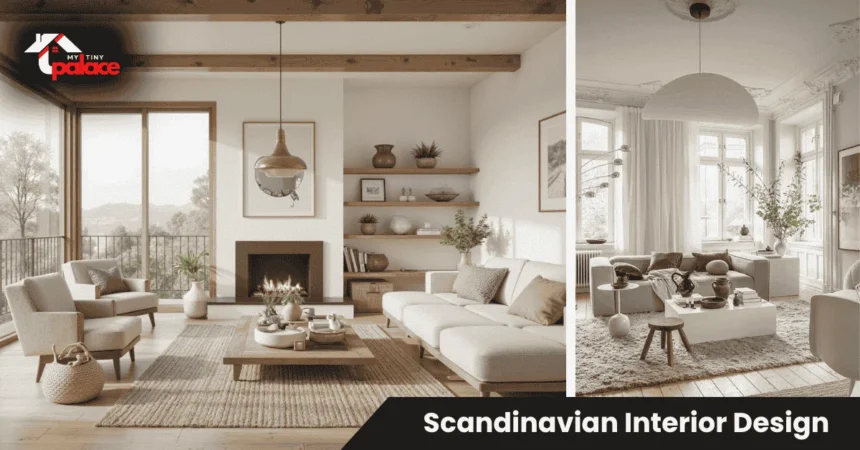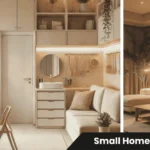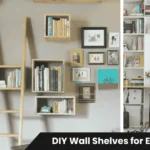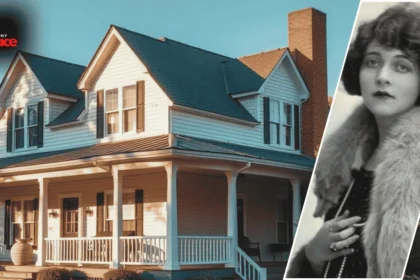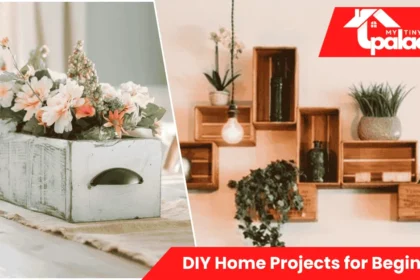Quick summary
Scandinavian interior design transforms small spaces into calm, functional retreats using light colors, natural materials, and simple furniture. You’ll learn how to start with affordable swaps, choose the right pieces, and create an airy home without a full renovation.
- Quick summary
- Scandinavian Interior Design: A Beginner’s Guide
- Why Scandinavian design works for small homes
- Core elements of Scandinavian interiors (furniture, materials, color)
- How to start in your home
- Materials, furniture choices, and where to invest
- Lighting and color tips for small spaces
- Costs, time, and tools
- Pros & cons — who should (and shouldn’t) consider it
- Quick summary + CTA
Scandinavian Interior Design: A Beginner’s Guide
Scandinavian interior design blends function with minimalism. It uses light palettes, natural materials like wood and wool, and clean-lined furniture to create calm, practical spaces. Born in the Nordic countries during the mid-20th century, this style prioritized warmth and livability during long, dark winters. Learn more about different design approaches in our Complete Guide to Interior Design Styles.
The approach feels simple but never cold. You get uncluttered rooms that still feel cozy through layered textiles and soft lighting. Every piece serves a purpose, so your space stays organized without constant effort. For beginners, the style offers clear rules: keep it light, choose natural textures, and edit out excess. That makes decorating decisions easier than styles with elaborate rules or trendy shifts.
“Scandinavian style makes small spaces feel calm and alive.”
You don’t need to gut your home or buy all new furniture. Start with what you have, remove clutter, and add a few key pieces. The style works for renters and homeowners alike because it relies on portable items like rugs, cushions, and lamps rather than built-in features.
Why Scandinavian design works for small homes
Small rooms need every advantage, and Nordic minimalism delivers three big ones: light reflection, visual simplicity, and multipurpose furniture.
First, the neutral color palette bounces natural light around. White or pale gray walls make a 200-square-foot bedroom feel larger than darker shades would. Add a mirror opposite your window, and you double the brightness without adding fixtures.
Second, minimal furniture keeps sightlines open. A low-profile sofa lets you see across the room instead of blocking views. Simple lines mean less visual clutter, so your eyes rest instead of jumping between patterns and colors.
Third, functional pieces solve space problems. A bench with hidden storage holds blankets and books. A drop-leaf table expands for dinner, then folds flat against the wall. You gain usable square footage without renting a bigger place. Discover more space-saving strategies in our Interior Design Tips for Small Apartments.
The emotional benefit matters too. Clutter triggers stress, and a calm room helps you unwind after work. When everything has a place and surfaces stay clear, you spend less time tidying and more time relaxing.
Imagine swapping a bulky entertainment center for a slim wall-mounted shelf. You gain floor space, the room feels taller, and you still store everything you need. That single change captures the Scandinavian approach: practical upgrades that improve daily life.
Core elements of Scandinavian interiors (furniture, materials, color)
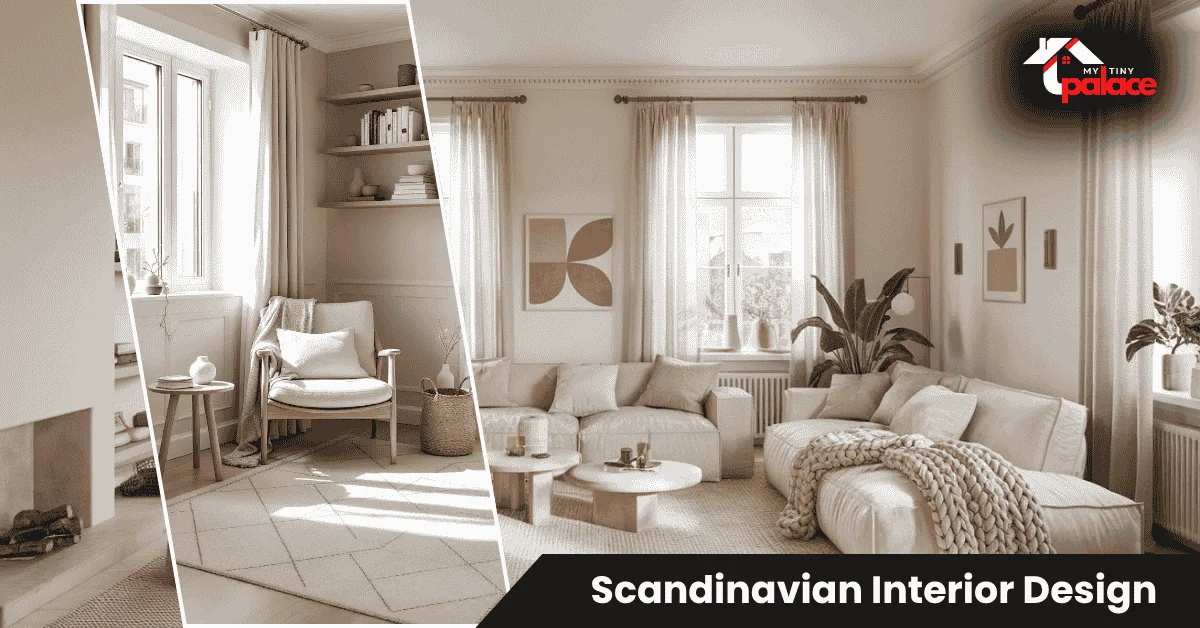
Five components define the look, and you’ll spot them in every Nordic-inspired room.
Light wood forms the foundation. Oak, birch, and pine bring warmth without heaviness. A pale wood floor reflects light upward, making ceilings feel higher. Wood furniture ages well and pairs with any textile color, so your investment lasts through trend cycles.
Neutral palette means whites, grays, and beiges dominate. These tones create a backdrop that calms rather than competes for attention. You can introduce contrast with black accents—a dark throw pillow or matte picture frame—to add depth without breaking the serene mood. Understanding Color Psychology in Interior Design can help you choose the right shades for your space.
Simple lines keep furniture functional and unadorned. No carved legs or fussy details. A dining chair might have gently curved edges for comfort, but the silhouette stays clean. This approach ages better than ornate styles and fits any room size.
Texture prevents boredom. Wool throws, linen curtains, and jute rugs add tactile interest. Layer a chunky knit blanket over a smooth sofa, or place a sheepskin on a wooden chair. These soft elements bring hygge—the cozy side of Scandinavian style—without adding visual clutter.
Functional storage hides everyday items. Closed cabinets, wall-mounted shelves, and modular units keep surfaces clear. Open shelving works if you display a few carefully chosen objects, but most storage should conceal rather than showcase.
Each element affects how you feel and move through space. Light wood warms the room. Neutrals soothe. Simple furniture lets you rearrange easily. Texture invites touch. Smart storage keeps you organized. Together, they create a system that maintains itself with minimal effort.
How to start in your home
You can shift toward Scandinavian decor ideas in two focused weeks using items you already own, plus a few affordable additions. No contractor needed.
Week 1 — declutter, maximize light, and swap textiles
Start by removing items you don’t use daily. Clear kitchen counters, pare down shelf displays, and box up excess decor. Less visual noise makes rooms breathe.
Next, wash your windows and remove heavy curtains. Replace them with sheer white panels or leave windows bare if privacy allows. Natural light costs nothing and transforms mood instantly.
Then swap textiles. Replace bright or patterned cushions with neutral linen or cotton covers. Add a white or gray throw. If your rug is dark or busy, roll it up and try the room without it. Sometimes bare wood floors work better in small spaces.
Week 2 — furniture edits, storage, and a focal piece
Measure your largest furniture pieces. If your sofa blocks walkways or your bed leaves less than two feet on each side, consider slimmer alternatives. You don’t need to buy immediately—just identify what feels oversized.
Add one storage solution: floating shelves, a narrow console, or baskets that slide under furniture. Use it to corral items currently sitting on surfaces.
Finally, choose one focal piece that embodies the style. A simple oak coffee table, a streamlined floor lamp, or a pale wood chair. This single investment anchors the room and gives you a reference point for future additions.
If you rent, choose removable hooks and lightweight shelving. Avoid anything requiring wall anchors unless your lease allows. Adhesive picture strips and freestanding units offer Scandinavian simplicity without deposit risk.
Materials, furniture choices, and where to invest
Prioritize quality where you sit, sleep, or see daily. Invest in a sofa or bed frame—solid wood or high-grade plywood beats particleboard for longevity. A well-made piece lasts 10-plus years and withstands moves and use.
Save on decor and textiles. Cushion covers and throws wear out faster, so buy affordable versions you can replace. Synthetic blends work fine for these items and cost less than pure wool or linen.
For wood furniture, solid oak or birch outperforms veneer if you plan to keep it long-term. Veneer chips more easily but costs half as much, making it smart for transitional pieces you’ll upgrade later.
Budget tiers look like this: low-cost items under $50 (cushions, small plants, picture frames), medium investments around $150-$400 (rugs, lamps, side tables), and larger purchases over $500 (sofas, dining tables, bed frames). Start with one medium piece and several low-cost swaps. Where to buy affordable Nordic furniture? Retailers like IKEA offer Scandinavian-inspired designs at accessible prices, while secondhand shops often carry mid-century pieces that fit the aesthetic.
Lighting and color tips for small spaces
Layer three types of light: ambient, task, and accent. A ceiling fixture provides overall brightness. A floor lamp illuminates reading corners. Small table lamps or strip lights under shelves add warmth at night.
The best colors for Scandinavian interiors start with white or pale gray walls. Add warm neutrals through wood tones and textiles. Introduce one dark element—maybe a black lamp or charcoal cushion—to anchor the palette and prevent washed-out flatness. Explore how colors affect mood and perception in our guide to Color Psychology in Interior Design.
In bedrooms, place a mirror across from the window to reflect morning light. Use warm-toned bulbs (2700-3000K) in lamps for evening coziness. Skip overhead lighting when you can; side lighting feels less harsh and more inviting.
For living areas, position your sofa near natural light sources. Keep window areas clear of tall furniture. If your room lacks windows, add multiple light sources at different heights to mimic natural brightness variation.
Muted pastels work as accents if you want subtle color. A blush pink throw or sage green plant pot adds personality without breaking the neutral base. Simple Scandinavian lighting tips for bedrooms include dimmable fixtures that adjust from bright mornings to soft evenings.
Costs, time, and tools
Realistic budgets and timelines help you plan without surprises.
| Level | Cost Range | Time Needed | Tools/Skills Required |
|---|---|---|---|
| Low | $200-$500 | 2-3 weekends | Basic (declutter, rearrange, textile swaps, no installation) |
| Medium | $800-$1,500 | 4-6 weeks | Some assembly (flat-pack furniture, hanging shelves with provided hardware) |
| Investment | $2,000-$4,000 | 2-3 months | May need pros (custom storage, lighting rewiring, floor refinishing) |
Most beginners start low and add over time. You can transform one room for under $500 by decluttering, buying new textiles, and adding one wood piece.
If you’re rewiring fixtures or installing hardwired ceiling lights, hire a licensed electrician. Incorrect wiring creates fire hazards. For everything else—painting, furniture assembly, hanging lightweight items—you can DIY with basic tools like a drill, level, and measuring tape.
Pros & cons — who should (and shouldn’t) consider it
Great for: People who want calm, organized spaces with minimal upkeep. Small apartments benefit most because the style maximizes light and function. Budget-conscious decorators appreciate the focus on affordable natural materials over trendy statements.
Less ideal for: If you love bold color, pattern mixing, or ornate details, Scandinavian design might feel too restrained. The neutral palette can look cold without enough texture. Maximalists who enjoy visual abundance may find it too minimal. Explore other aesthetics that might suit your taste in our Complete Guide to Interior Design Styles.
Is Scandinavian design minimal or cozy? It’s both. The structure stays minimal, but layered textiles and warm lighting create coziness. Think of it as organized comfort rather than stark emptiness.
The style holds up well over time. Neutral bases don’t date like trendy colors, and quality wood furniture improves with age. You spend less on replacement and more on thoughtful upgrades.
Quick summary + CTA
Start by decluttering one room, maximizing natural light, and adding one investment piece in light wood. That combination delivers immediate impact without overwhelming your budget or timeline.
Try your bedroom or living room first—these spaces affect your daily mood the most. Measure before buying to avoid returns. Save a mood board on Pinterest with rooms you admire, then identify common elements like color, furniture shape, or lighting style.
How long does a room refresh take? Most people see results in 2-4 weeks. Shop a starter list of three items: neutral throw pillows, a simple lamp, and one wood accent piece. Those changes alone shift the feel from cluttered to calm.






